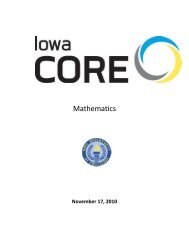The Arc's Self-Determination Scale: Procedural Guidelines
The Arc's Self-Determination Scale: Procedural Guidelines
The Arc's Self-Determination Scale: Procedural Guidelines
Create successful ePaper yourself
Turn your PDF publications into a flip-book with our unique Google optimized e-Paper software.
or overly intrusive interventions or placements. When considering<br />
the assessment of self-determination, there is a need to be<br />
cognizant not only of the possible contributions of such an effort,<br />
but the potential limitations of the exercise as well. <strong>The</strong>se issues<br />
are compounded when the assessment in question is a self-report<br />
measure. <strong>The</strong> Arc’s <strong>Self</strong>-<strong>Determination</strong> <strong>Scale</strong> was designed to be<br />
a tool to enable and empower students to become more selfdetermined<br />
by providing a vehicle by which they can, with<br />
appropriate supports and accommodations: (1) evaluate their own<br />
beliefs about themselves and their self-determination; (2) work<br />
collaboratively with educators and others to identify individual<br />
areas of strength and limitations related to self-determination goals<br />
and objectives; and, (3) self-assess progress in self-determination<br />
over time. In addition, <strong>The</strong> Arc’s <strong>Self</strong>-<strong>Determination</strong> <strong>Scale</strong> can<br />
benefit students by providing researchers a tool to evaluate which<br />
environments, instructional strategies and curricular materials<br />
enhance or impede self-determination.<br />
<strong>The</strong> voices of students with disabilities are often the least<br />
frequently heard or solicited voice in the educational planning,<br />
decision-making, and program implementation process. This is<br />
adequately illustrated by the current state of affairs regarding<br />
student involvement in educational planning meetings. <strong>The</strong> reality<br />
for too many students with disabilities is that they are, essentially,<br />
left out of this process (Gillespie & Turnbull, 1983; Van Reusen &<br />
Bos, 1990). <strong>The</strong> implementation of P.L. 94-142 opened the door<br />
for student involvement in educational planning and decisionmaking<br />
by requiring the participation of students in planning<br />
meetings, whenever appropriate. Unfortunately, as Gillespie and<br />
Turnbull (1983) pointed out, little effort was expended to<br />
determine just when whenever appropriate was and most students<br />
were either uninvolved in the process, or involved only<br />
peripherally. Van Reusen and Bos (1990) stated that “student<br />
involvement [in educational planning], even at the secondary level,<br />
is for the most part either nonexistent or passive” (p. 30). If this is<br />
true for student-involvement in the IEP meeting, it is equally the<br />
case for the educational program planning and implementation<br />
process, despite evidence that such involvement would benefit<br />
students and result in more positive educational outcomes.<br />
<strong>The</strong> Arc’s <strong>Self</strong>-<strong>Determination</strong> <strong>Scale</strong> was conceptualized as a<br />
vehicle to reverse this trend by providing a self-report indicator of<br />
self-determination. <strong>The</strong> intent of the process is first and foremost<br />
to provide a voice for students with disabilities in this important<br />
area. However, there is considerable debate regarding the use of<br />
self-report measures, particularly with students with mental<br />
retardation. <strong>The</strong> <strong>Scale</strong> Construction and Development chapter<br />
provides a detailed discussion of the procedures used to determine<br />
8
















